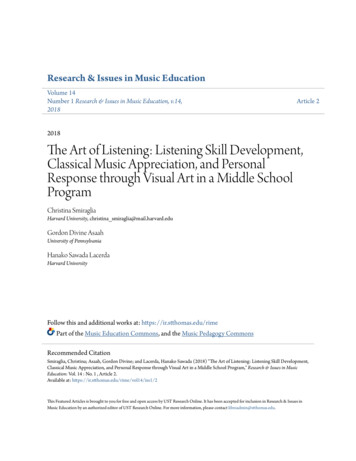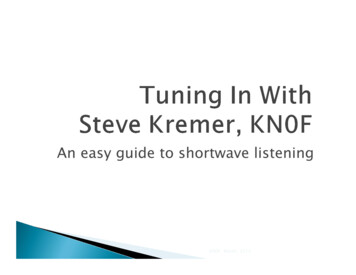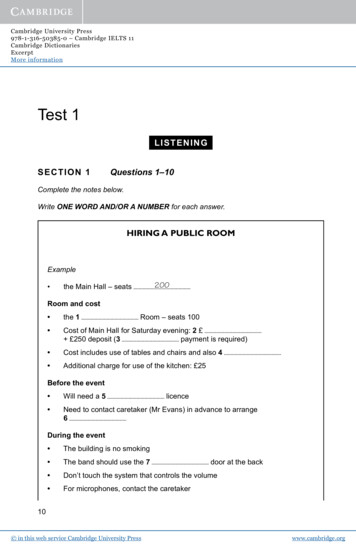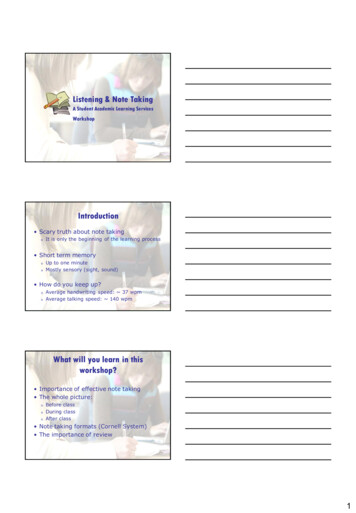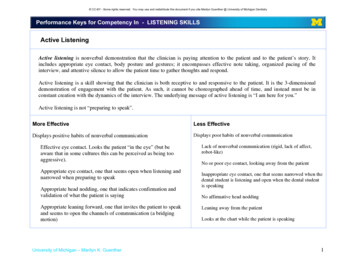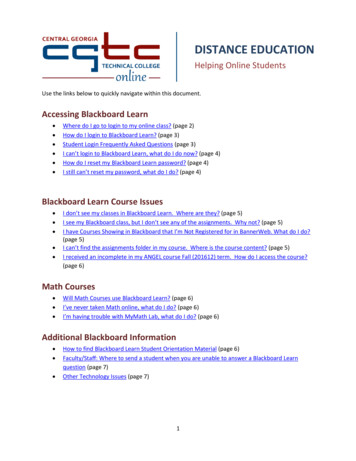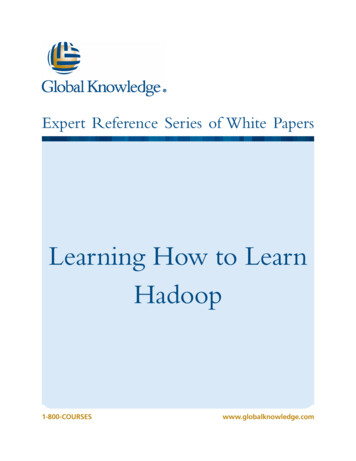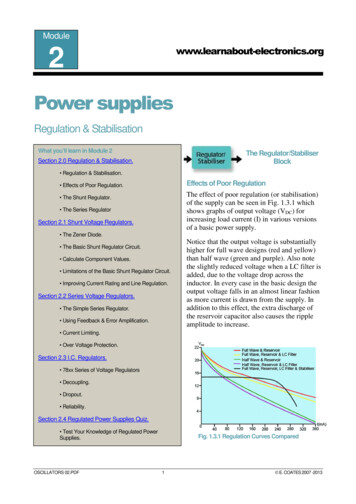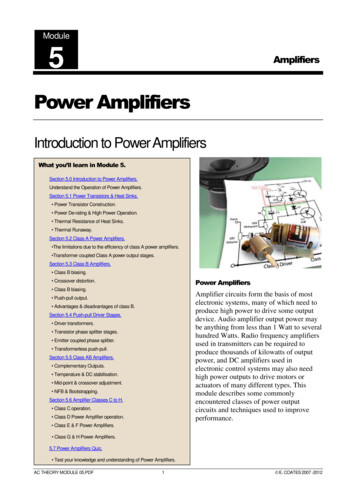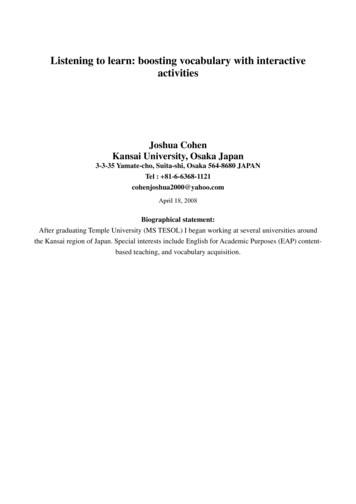
Transcription
Listening to learn: boosting vocabulary with interactiveactivitiesJoshua CohenKansai University, Osaka Japan3-3-35 Yamate-cho, Suita-shi, Osaka 564-8680 JAPANTel : 81-6-6368-1121cohenjoshua2000@yahoo.comApril 18, 2008Biographical statement:After graduating Temple University (MS TESOL) I began working at several universities aroundthe Kansai region of Japan. Special interests include English for Academic Purposes (EAP) contentbased teaching, and vocabulary acquisition.
Keywords:vocabulary, listening, interactive activities, aural inputIntroductionDespite being one of our most important and most often used modalities, listening is an area of languageinstruction that is often overlooked by teachers and researchers alike as fertile ground for theenhancement of students' vocabulary knowledge. For low-level learners, especially those not in fullcontrol of the first 2000 most-frequent words of English, listening may be the fastest route to acquiring alarger, more effective and retained vocabulary. At higher levels, word learning can also be enhancedthrough exposure to aural input. Incorporating a variety of vocabulary-based activities into listeningexercises will help strengthen students' understanding of words and word meanings at every level.
Much of the vocabulary acquisition research has focused on reading as the primary measure ofsuccess. Research on vocabulary acquisition through listening is limited, although promising workis being reported. Studies by Elley (1989) and Brett, Rothlein, and Hurley (1996) clearly establishthat gains in vocabulary via listening are possible even with limited exposure to new words. Bothstudies demonstrate that learners studying in their first language are able, through listening, toacquire target vocabulary with minimal repetition even when teachers did not stop to explain themeanings of words; when teachers stopped and explained meanings, acquisition went upappreciably. Vidal (2003) found that listening to academic lectures in English can also beconsidered a source for vocabulary acquisition, where students listening to three lectures showedmoderate gains in vocabulary. The reverse appears to be true regarding learning words throughreading – Waring and Takaki (2003) showed that recall was poor when students read words justonce.Although most words are thought to be learned incidentally, providing learners with explicittraining in vocabulary is an even more effective way to deliver words and phrases, especially atlower levels. There are many ways of doing this, but listening to stories, long texts and other auralinput may have more promise than was otherwise thought in supporting vocabulary acquisitionthrough listening. In his discussion on how learners pick up new vocabulary through listening tostories, Nation (2001) outlined five important conditions which can easily be adapted to fit withinany interactive vocabulary program. His conditions, elucidated below, are: interest, comprehension,repeated retrieval, decontextualization, and generative processing.Interest is perhaps the most important condition of acquiring new vocabulary. In order for learnersto become fully absorbed in texts, their curiosity must first be piqued, hence listening texts need tobe interesting to hold students' attention. One way to ensure learner curiosity is for teachers tochoose intrinsically interesting passages or texts. Elley (1989) interpreted discordant amounts ofvocabulary learning from two stories by lack of concentration. Students in his study processedlanguage at deeper levels due to their intense involvement with the stories. Penno, Moore, andWilkinson (2002) also found the choice of text is an important factor in students' learning andvocabulary gains. Teachers should not expect learners to be receptive to boring material. Students'opinions should be part of the decision-making process when selecting texts or passages. Studentswill more readily participate in activities when they have had a hand in the choice of materials to beused, and will have an impact on maintaining their interest in new activities as long as they canparticipate in the selection of materials. Teachers can also maintain students' interest levels bybreaking up listening passages into sections, serializing the text and listening to it in portions over aspan of time. This can help build the the excitement of the next installment while also allowingmore opportunities to practice difficult vocabulary.Comprehension refers to learners' ability to recognize and understand what they hear. Passageswith large amounts of new or difficult vocabulary carry a heavier cognitive load and are inherentlymore difficult to understand. In her study of first-year EFL university students' vocabularyacquisition and lecture comprehension, Vidal (2003, p. 79) found a high correlation betweenlanguage acuity and understanding, leading her to speculate that “the higher the level of lecturecomprehension, the greater the vocabulary gain.” The degree to which a lecture is understoodinfluences students' vocabulary acquisition. According to Nation (2001), if the density of unknownwords in a written fiction text reaches below 95% of the running words, comprehension is likely tobe inadequate. It is easy to infer from Nation's findings that the same holds true for unknown wordsfound in a listening text. The number should be minimal; perhaps about 1 in 100 for completecomprehension.Repeated retrieval refers to exposure. Learners need to meet target vocabulary as many times aspossible. Both Elley (1989) and Brett et al., (1996) observed that the number of times a word
occurred in a story (i.e. frequency) was positively related to the likelihood that a student wouldlearn that word. Interestingly, Vidal (2003) showed that word frequency was indeed a factor inrecognition and retrieval, but not nearly as influential as the word's predictability from its parts, itstype, or a subsequent gloss provided by an teacher. An easy way to make sure students meet newwords in the same context is to repeat the number of times a listening is heard. In so doing, theteacher guarantees the target words will be heard, and heard again. Like its reading counterpart,'narrow' listening can also be an effective way to ensure listeners hear the same types of words in avariety of contexts falling within one genre. If the passage is a long one, breaking it up and listeningto it serially is another way to keep the quality and persistence with which students listen high.Teachers can have students listen over the duration of week, a month or even over the course ofsemester. Another way to help listeners encounter the same words is for the teacher or students toretell the passage in groups, either prior to or directly after the listening is completed. Alternatively,the teacher can retell the story up until the point where the class will start listening from, embeddingkey vocabulary as he or she goes.Decontextualization is one of the most popular ways for teachers to introduce new vocabulary tostudents. Essentially, it consists of drawing learners' attention away from the listening passage as awhole and focusing directly onto the words contained within the text. This can be accomplished inmany ways such as writing the words on the blackboard as they occur in the text, pausing to defineand explain the word, or even in a pre-listening exercise where new vocabulary is introduced andinserted through some kind of task. Elley (1989) Brett et al., (1996) and Penno et al., (2002) allfound that vocabulary learning is considerably increased if teachers stop to explain or elaborate onwords as they come up in a story. In contrast, Vidal (2003) found that contextualization ofvocabulary embedded within a passage was enough for students to learn vocabulary. In her study,target words that were defined in the surrounding context of the listening passage were more likelyto be learned.Generative processing refers to encountering vocabulary in broad and varied ways, thus stretchingthe conceptualization of meaning a word has. Generative word use occurs when teachers makesentences using words in ways that differ from the way they appear in the text (Nation, 2001). Longtexts and serial listenings provide excellent opportunities for the same vocabulary to recur.Recurrences provide learners with the benefit of hearing the word used generatively. Using pictures,listening to sound bytes, looking at magazine clipping or other authentic realia may also helpprovide learners with the opportunity for greater negotiation of words previously encountered,especially when accompanied by a task. Another way to supply learners with generative uses ofwords is to give them simple, contextual definitions of words using sample sentences.Including interactive vocabulary activitiesLooking beyond Nation's five conditions of vocabulary learning, Paribakht and Wesche (1997)propose a skills checklist of interactive vocabulary activities. They suggest that interactiveclassroom vocabulary practice can be designed to accomplish the following hierarchy of mentalprocesses including: selective attention, recognition, manipulation, interpretation and production.These two processes (Nation's conditions and Paribakht and Wesche's skills) can be merged in theclassroom setting, giving the teacher a broad palette to work with when designing vocabularyexposure and retention exercises.Selective attention uses basic 'listen and do' techniques to focus a learner's attention on targetwords. It has the goal of making students certain to notice target words, which may be the first stepin word acquisition. Students can be asked to underline, circle, high-light, or boldface words andphrases heard in listening texts. Exercises like these are thought to be the least challenging forlearners.
Recognition practice provides learners with the essential parts of an exercise and asks them torecognize target words and their meanings; thus partial knowledge of target vocabulary is enough tocomplete these types of tasks. Examples include matching pictures after hearing target words,choosing the correct word to label a picture, or matching a target word with a definition.Manipulation requires participants to rearrange and organize given elements to make words orphrases. They can also be used to draw on students' knowledge of grammar and word morphology.Examples of these type of exercises include changing the inflection of word endings, changingnouns to adjectives and using stems or affixes to make words.Interpretation involves the analysis of word meanings with respect to other words in a givencontext (i.e., collocations, multi-word units). Teachers can ask students why certain phrases orexpressions were used in a listening text or to find the odd word in series of collocationally relatedwords. Students might also work to arrange target words into lists or define words heard in context.Production practice requires the learner to produce target words in appropriate contexts. Examplesof these types of activities include labeling pictures, answering questions using the target word, orhearing the L1 target word and providing an L2 definition.Adapting Paribakht and Wesche's hierarchy for processing vocabulary with Nation's discussion onvocabulary acquisition through storytelling, I offer the following interactive activities for use inlistening classes. The processes described above should probably be included at all stages oflanguage proficiency, however the amount of class time devoted to such tasks should varyaccording to the level of the student.True beginner to false beginner: listening exercises and activitiesAt the beginning levels of language and vocabulary acquisition, lower proficiency students – saythose with a vocabulary of 100 to 200 words – need exposure to lots of words. Providing studentswith opportunities to notice words is probably a good first step, followed by interactive activities tohelp gel the learning process. Approaches like Total Physical Response and Teaching PhysicalResponse Storytelling may have added value in injecting into learners' vocabulary, a core ofessential vocabulary words. Later, as students develop their vocabulary into the 500-plus wordlevels, a variety of other interactive activities can take place. What follows is a proposal of exercisesdesigned to enhance vocabulary growth through listening.1. Decontextualized recognition of differences (selective attention)A simple way to train students to detect the differences between words that sound similar but havedifferent meanings is to have them listen to word groupings and 'spot' the difference.Exercise 1.1Directions: raise your hand when you hear a word that is different:1. dairydairydailydairy2. butterbetterbetterbetter3. fastfastfistfastThis exercise can also be done in pairs if students are capable of reading the target words. Pairs readword lists to each other and signal when they hear a different sound. This would strengthen theconnections participants make with the words. Boldfacing, italicizing, circling, underlining orcoloring words heard in a text may also impact on the word learning that occurs during a listening.
2. Generative schema building (recognition, selective attention)At lower levels of vocabulary learning, providing a framework for the association of new words canalso help learners progress and contribute toward building their schemata. Exercises in this categoryprovide learners with prerequisite pieces and ask them to recognize target words and theirmeanings. Examples include: matching target words with definitions or synonyms; recognizing themeaning of a word from a bank of choices; choosing the correct picture after hearing the targetword; numbering a series of pictures based on a sequence of the items; choosing the right word tolabel a picture; hearing a target word in the L2 and giving an L1 equivalent.Exercise 2.1Read aloud or place three or four vocabulary words in succession:cottagetentcliffcabinDirections: Ask students questions which will encourage them to discriminate between the items.For example, Which of these is not a place to live? Which of them can you carry with you? Whichdoesn't start with a /k/ sound?Exercise 2.2Start with a simple sentence that can allow for additional vocabulary words to be slotted into theexercise. The words used should come from within the schema, however students' attention can alsobe directed toward grammatical features as well. A common example is, I went to the supermarketyesterday and bought tomatoes, potatoes and a quart of milk. The students work in groups, witheach student repeating the previous sentence and adding additional words to increase the length ofthe list.3. Decontextualized semantic framing (recognition, interpretation, manipulation)As previously mentioned, providing a systematic framework for vocabulary that is part of largerschemata can be helpful for lower-proficiency learners. Categorization of vocabulary requiresdeeper processing by learners and may lead to greater comprehension. Examples include foods(meats, cheeses, fruits) occupations (doctor, driver, fireman) or genres of movies (action, love story,documentary). Since lower-level students are unlikely to have these sets, the first step is for theteacher to supply them. Presentation can take many forms, including written lists or dictations. Inexercises like these, it is important to keep in mind that the main thrust of the activity is on the wayin which vocabulary words can be categorized, rather than the vocabulary words themselves.Exercise 3.1AnimalMeatMeatpigporkbacon, hamcowbeefburger, steakchickenchicken(adapted from Courtright and Wesolek, 2001)Almost at once students can begin to see the system as well as come to understand more basicvocabulary. The following exercise can help beginning students practice what they've just learned.Here students explain why they chose to cross out the word they did. For example, in number onebelow, a hospital is not an occupation but a place where doctors and nurses work.Exercise 3.2Directions: cross out the word that doesn't belong in the group1. doctornursehospital2. pigchickenbeef3. actionpaintinglove story
(adapted from Courtright and Wesolek, 2001)This can exercise can be expanded on by asking students to produce items missing in a chart.Students can read the lists to their partners or work alone to produce the answers.Exercise 3.3Directions: Fill in the missing spacesMovie typesactionlove storyFoodsbaconsteak4. Contextualized grammatical framing (recognition, manipulation, interpretation, production)Even at the lowest levels, students can benefit from basic focus-on-form instructional techniques.Making distinctions among vocabulary words is a listening, reading, writing and speaking skill thatshould be introduced early on in language classes. For example, many students are familiar with theword easy but may be unaware of the connection it has to the word ease. A part-of-speech chart isone tried-and-true way to help students make these connections. After listening to a passage,students are asked to complete a chart based on words contained within the text.Exercise 4.1NounVerbeasyAdjectiveterrificAdverbSince beginning-level listening passages are often highly contrived, they can be designed to containsome of the above word forms, but very seldom contain more than one. They also tend to be quiteshort. Without hearing the words in meaningful contexts, students may have no choice but to go tothe dictionary and look up the word, however a dictionary definition at this stage of developmentmay not provide enough context to be successful. Vocabulary word cards complete with parts ofspeech, etc., vocabulary notebooks and explicit training in dictionary work are all commonremedies for this issue. As students begin to get a feel for how word families go together it may beuseful for them to produce sentences, either in writing or orally. Production exercises like the onebelow may be more appropriate for students past the initial stages of vocabulary development or forthose nearing the 1500-2000 word level of competency.Exercise 4.2Directions: Write (say) short sentences using the following words. Choose only one of the words:n. gladnessn. probablen. easen. drinkn. friendadj. gladadj. probablev. easesv. drinkadj. friendlyadv. gladlyadv. probably(adapted from Courtright and Wesolek, 2001)Exercises like this one and the one preceding it may offer other types of benefits to learners. Forexample, they help demonstrate to students that some word families have differing numbers ofmembers. And they can also help students to understand the rules of inflections, such as in theadverbial ending -ly.low-intermediate – intermediate: listening exercises and activities
Beginning level vocabulary and listening practices typically tend to focus on developing selectiveattention and recognition skills. At the intermediate level of instruction teachers can inject morefocused vocabulary training, expanding on students' lexical background with more intensivepractice in manipulation, interpretation, and production of words. Whereas lower-proficiencystudents tend to use words to communicate basic needs, intermediate-level students often strugglewith the inability to say exactly what they mean. In these cases, expanding their vocabulary toinclude synonyms, longer word phrases and collocations may be effective. Teachers can designexercises which incorporate the skills of higher-level processing together with other ways ofaddressing the same concept.1. Distinguishing similar vocabulary items within a group (manipulation, recognition,interpretation)ExerciseDirections: Give an example of a food that is packaged in each of the following rigerator dishThis kind of vocabulary practice can easily be fit in before, during or after a listening on food.Activities like this give stud
Kansai University, Osaka Japan 3-3-35 Yamate-cho, Suita-shi, Osaka 564-8680 JAPAN Tel : 81-6-6368-1121 cohenjoshua2000@yahoo.com Biographical statement: After graduating Temple University (MS TESOL) I began working at several universities around the Kansai region of Japan. Special interests include English for Academic Purposes (EAP) content-
